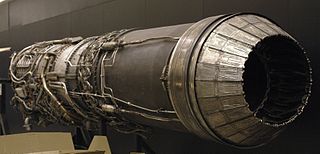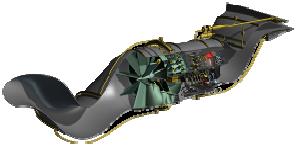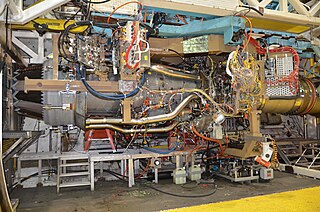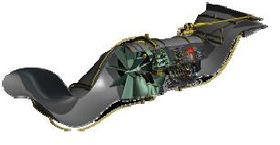
The Lockheed Martin F-35 Lightning II is an American family of single-seat, single-engine, stealth multirole combat aircraft designed for air superiority and strike missions; it also has electronic warfare and intelligence, surveillance, and reconnaissance capabilities. Lockheed Martin is the prime F-35 contractor with principal partners Northrop Grumman and BAE Systems. The aircraft has three main variants: the conventional takeoff and landing (CTOL) F-35A, the short take-off and vertical-landing (STOVL) F-35B, and the carrier-based (CV/CATOBAR) F-35C.

The Lockheed Martin X-35 is a concept demonstrator aircraft (CDA) developed by Lockheed Martin for the Joint Strike Fighter program. The X-35 was declared the winner over the competing Boeing X-32 and a developed, armed version went on to enter production in the early 21st century as the F-35 Lightning II.

The General Electric/Rolls-Royce F136 was an advanced turbofan engine being developed by General Electric and Rolls-Royce plc for the Lockheed Martin F-35 Lightning II. The two companies stopped work on the project in December 2011 after failing to gather Pentagon support for further development.

The Rolls-Royce BR700 is a family of turbofan engines for regional jets and corporate jets. It is manufactured in Dahlewitz, Germany, by Rolls-Royce Deutschland: this was initially a joint venture of BMW and Rolls-Royce plc established in 1990 to develop this engine. The BR710 first ran in 1995. The United States military designation for the BR725 variant is F130.

The General Electric F110 is an afterburning turbofan jet engine produced by GE Aerospace. It was derived from the General Electric F101 as an alternative engine to the Pratt & Whitney F100 for powering tactical fighter aircraft, with the F-16C Fighting Falcon and F-14A+/B Tomcat being the initial platforms; the F110 would eventually power new F-15 Eagle variants as well. The engine is also built by IHI Corporation in Japan, TUSAŞ Engine Industries (TEI) in Turkey, and Samsung Techwin in South Korea as part of licensing agreements.

The Boeing X-32 is a concept demonstrator aircraft that was designed for the Joint Strike Fighter competition. It lost to the Lockheed Martin X-35 demonstrator, which was further developed into the Lockheed Martin F-35 Lightning II.

The Pratt & Whitney F119, company designation PW5000, is an afterburning turbofan engine developed by Pratt & Whitney for the Advanced Tactical Fighter (ATF) program, which resulted in the Lockheed Martin F-22 Raptor. The engine delivers thrust in the 35,000 lbf (156 kN) class and was designed for sustained supersonic flight without afterburners, or supercruise. Delivering almost 22% more thrust with 40% fewer parts than its F100 predecessor, the F119 allows the F-22 to achieve supercruise speeds of up to Mach 1.8. The F119's nozzles incorporate thrust vectoring that enable them to direct the engine thrust ±20° in the pitch axis to give the F-22 enhanced maneuverability.

The Pratt & Whitney F135 is an afterburning turbofan developed for the Lockheed Martin F-35 Lightning II, a single-engine strike fighter. It has two variants; a Conventional Take-Off and Landing (CTOL) variant used in the F-35A and F-35C, and a two-cycle Short Take-Off Vertical Landing (STOVL) variant used in the F-35B that includes a forward lift fan. The first production engines were delivered in 2009.

The Pratt & Whitney F100 is a low bypass afterburning turbofan engine. It was designed and manufactured by Pratt & Whitney to power the U.S. Air Force's "FX" initiative in 1965, which became the F-15 Eagle. The engine was to be developed in tandem with the F401 which shares a similar core but with an upscaled fan for the U.S. Navy's F-14 Tomcat. The F401 was later abandoned due to costs and reliability issues. The F100 also powered the F-16 Fighting Falcon for the Air Force's Lightweight Fighter (LWF) program.

The General Electric J79 is an axial-flow turbojet engine built for use in a variety of fighter and bomber aircraft and a supersonic cruise missile. The J79 was produced by General Electric Aircraft Engines in the United States, and under license by several other companies worldwide. Among its major uses was the Lockheed F-104 Starfighter, Convair B-58 Hustler, McDonnell Douglas F-4 Phantom II, North American A-5 Vigilante and IAI Kfir.

The General Electric F414 is an American afterburning turbofan engine in the 22,000-pound thrust class produced by GE Aerospace. The F414 originated from GE's widely used F404 turbofan, enlarged and improved for use in the Boeing F/A-18E/F Super Hornet. The engine was developed from the F412 non-afterburning turbofan planned for the A-12 Avenger II, before it was canceled.

The General Electric YF120, internally designated as GE37, was a variable cycle afterburning turbofan engine designed by General Electric Aircraft Engines in the late 1980s and early 1990s for the United States Air Force's Advanced Tactical Fighter (ATF) program. It was designed to produce maximum thrust in the 35,000 lbf (156 kN) class. Prototype engines were installed in the two competing technology demonstrator aircraft, the Lockheed YF-22 and Northrop YF-23.

A variable cycle engine (VCE), also referred to as adaptive cycle engine (ACE), is an aircraft jet engine that is designed to operate efficiently under mixed flight conditions, such as subsonic, transonic and supersonic.

The Rolls-Royce LiftSystem, together with the F135 engine, is an aircraft propulsion system designed for use in the STOVL variant of the F-35 Lightning II. The complete system, known as the Integrated Lift Fan Propulsion System (ILFPS), was awarded the Collier Trophy in 2001.

The General Electric Passport is a turbofan developed by GE Aerospace for large business jets. It was selected in 2010 to power the Bombardier Global 7500 and 8000, first run on June 24, 2013, and first flown in 2015. It was certified in April 2016 and powered the Global 7500 first flight on November 4, 2016, before its 2018 introduction. It produces 14,000 to 20,000 lbf of thrust, a range previously covered by the General Electric CF34. A smaller scaled CFM LEAP, it is a twin-spool axial engine with a 5.6:1 bypass ratio and a 45:1 overall pressure ratio and is noted for its large one-piece 52 in (130 cm) fan 18-blade titanium blisk.

The General Electric XA100 is an American adaptive cycle engine demonstrator being developed by General Electric (GE) for the Lockheed Martin F-35 Lightning II and form the technological foundation for the company's XA102 propulsion system for the United States Air Force's sixth generation fighter program, the Next Generation Air Dominance (NGAD).

The Pratt & Whitney XA101 is an American adaptive cycle engine demonstrator being developed by Pratt & Whitney for the Lockheed Martin F-35 Lightning II and form the technological foundation for the company's XA103 propulsion system for the United States Air Force's sixth generation fighter program, the Next Generation Air Dominance (NGAD).
The General Electric XA102 is an American adaptive cycle engine demonstrator being developed by General Electric (GE). It is competing with the Pratt & Whitney XA103 as the powerplant for the United States Air Force's sixth generation fighter program, the Next Generation Air Dominance (NGAD).
The Pratt & Whitney XA103 is an American adaptive cycle engine demonstrator being developed by Pratt & Whitney. It is competing with the General Electric XA102 as the powerplant for the United States Air Force's sixth generation fighter program, the Next Generation Air Dominance (NGAD).
















